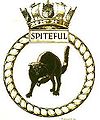.gif)
HMS Spiteful (P227)
Encyclopedia
HMS Spiteful (pennant number P227) was a S-class
British S class submarine (1931)
The S-class submarines of the Royal Navy were originally designed and built during the modernisation of the submarine force in the early 1930s to meet the need for smaller boats to patrol the restricted waters of the North Sea and the Mediterranean Sea replacing the British H class submarines...
submarine
Submarine
A submarine is a watercraft capable of independent operation below the surface of the water. It differs from a submersible, which has more limited underwater capability...
of the British
United Kingdom
The United Kingdom of Great Britain and Northern IrelandIn the United Kingdom and Dependencies, other languages have been officially recognised as legitimate autochthonous languages under the European Charter for Regional or Minority Languages...
Royal Navy
Royal Navy
The Royal Navy is the naval warfare service branch of the British Armed Forces. Founded in the 16th century, it is the oldest service branch and is known as the Senior Service...
.
Commander

World War II
World War II, or the Second World War , was a global conflict lasting from 1939 to 1945, involving most of the world's nations—including all of the great powers—eventually forming two opposing military alliances: the Allies and the Axis...
, (slightly pre-dating Edward Young's command of HMS Storm
HMS Storm (P233)
HMS Storm was an S-class submarine of the Royal Navy, and part of the third group built of that class. She was built by Cammell Laird and launched on 18 May 1943. So far, she is the only RN ship to bear the name Storm....
) from the time she was built until she was lent to the French. Sherwood was also Ben Bryant's 1st Lieutenant in both HMS Sealion
HMS Sealion (72S)
HMS Sealion was a Royal Navy S-class submarine which was launched 16 March 1934 and fought in the Second World War.She had an eventful career after the outbreak of war. Under the command of LCdr Ben Bryant, she attacked U-21 off the Dogger Bank in November 1939, but failed to sink her...
and HMS Safari
HMS Safari (P211)
HMS Safari, launched in November 1941, was one of the third group of British S-class submarines built by Cammell Laird & Co Limited, Birkenhead. So far she has been the only ship to bear the name Safari.-Career:...
, 3rd Flotilla. She travelled to HMS Forth, Holy Loch
Holy Loch
The Holy Loch is a sea loch in Argyll and Bute, Scotland.Robertson's Yard at Sandbank, a village on the loch, was a major wooden boat building company in the late 19th and early 20th centuries....
for her work-up.
Career
Her first war patrol was in the North Atlantic, from 29 December 1943 to 12 January 1944. She returned to LerwickLerwick
Lerwick is the capital and main port of the Shetland Islands, Scotland, located more than 100 miles off the north coast of mainland Scotland on the east coast of the Shetland Mainland...
, in Shetland, where a battery was replaced and a "singing" screw was repaired.
She sailed for Ceylon, arriving in April 1944. She was assigned to 8th Flotilla, HMS Maidstone
HMS Maidstone (1937)
HMS Maidstone was a submarine depot ship of the Royal Navy.-Facilities:She was built to support the increasing numbers of submarines, especially on distant stations, such as the Mediterranean and the Pacific Far East...
. She made two patrols, then transited to Fremantle. She sunk a number of Japanese vessels with gunfire, on June 30th, July 2nd and December 14th.
Another incident involved USS Gabilan
USS Gabilan (SS-252)
, a Gato-class submarine, was the only ship of the United States Navy to be named for the gabilan, an eagle-ray fish of the Gulf of California....
, when the American ship almost fired upon her, before recognising her as a friendly ship.
Spiteful then bombarded installations on the Andaman Islands and Christmas Island. She made three further patrols, totalling 109 days at sea - the three longest patrols by any 'S' class submarine - 34, 38 and 37 days (Sirdar achieved one of 49 days) - with little luck. She returned to the UK in April 1945 for a refit.
She was loaned to France as Sirene from 1952 to 1958.
On 1 July 1963 she arrived at Faslane to be broken up 15 July 1963.

